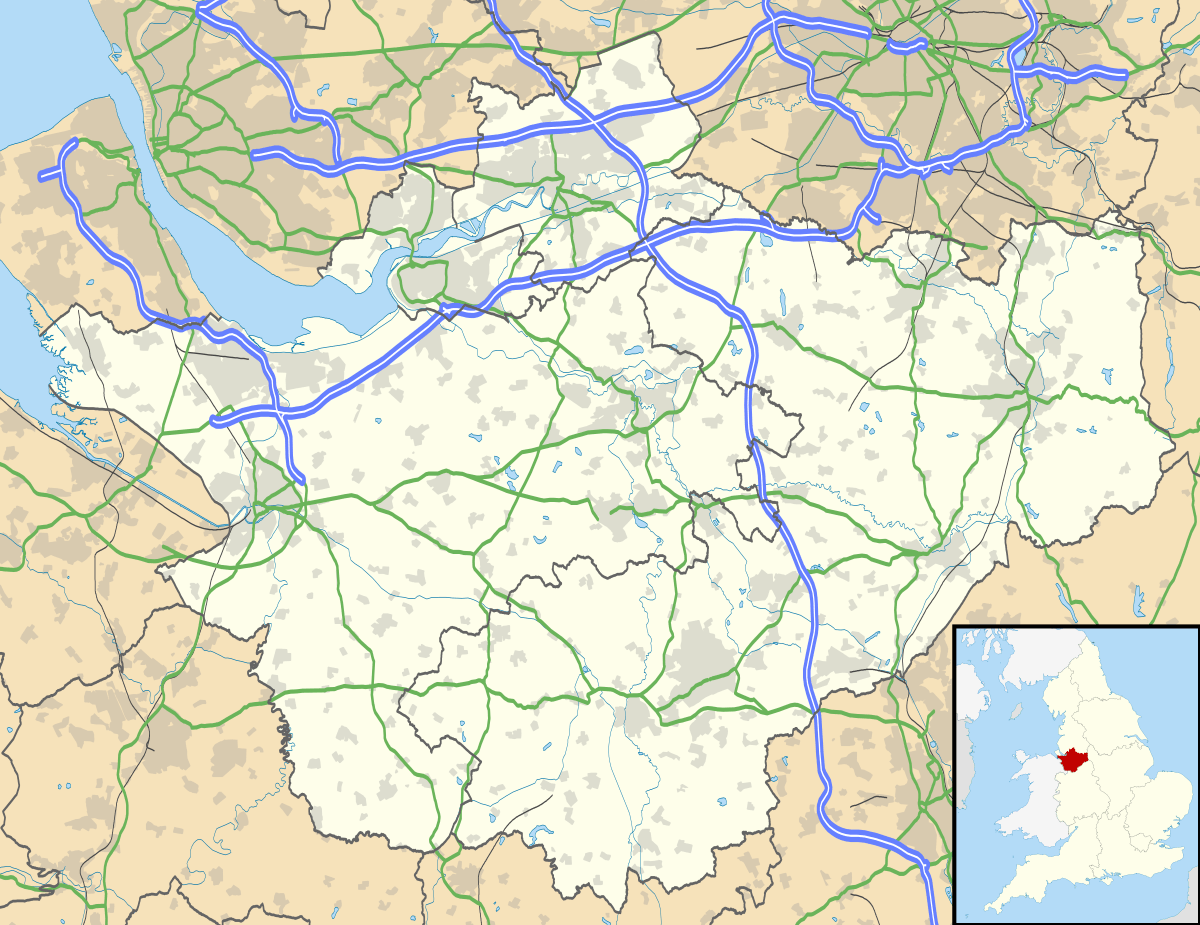RAF Cranage
| RAF Cranage | |
|---|---|
| Located Near Middlewich, Cheshire, England | |
 RAF Cranage | |
| Coordinates |
53°13′16″N 2°24′05″W / 53.2210°N 2.4013°WCoordinates: 53°13′16″N 2°24′05″W / 53.2210°N 2.4013°W grid reference SJ733694 |
| Type | Royal Air Force station |
| Site information | |
| Condition | Closed |
| Site history | |
| Built | 1939 |
| In use | 1940–1958 |
| Battles/wars | Second World War |
| Garrison information | |
| Occupants | RAF Flying Training Command |
Royal Air Force Cranage or more simply RAF Cranage is a former Royal Air Force station operated during the Second World War. It was located just to the North of Middlewich, Cheshire, England.
History
The site at Cranage was chosen for use as a training station and aircraft maintenance unit in August 1939. Originally just a grass airfield, three runways were later built from American metal plank. The airfield unusually had eight blister hangars for maintenance use.[1]
The first flying unit was No. 2 School of Air Navigation RAF which was formed on 21 October 1940.[2] It operated the twin-engined Avro Anson for training navigators. In 1942 the unit was renamed the Central Navigation School and the strength was increased to 58 Ansons, they were joined two years later by a number of Vickers Wellingtons in the same role.[3]
As well as the training role, the airfield also housed an operational squadron from December 1940 with the formation of 96 Squadron which was equipped with Hawker Hurricanes. This unit operated in the night air-defence role, mainly in the protection of the industrial and port areas of Liverpool.[4]
A Vickers-Armstrongs shadow factory assembling Wellingtons, was situated at Byley but close to the airfield. The completed aircraft would be towed from the factory to the airfield for their first flight and onward delivery.[5] In July 1942 1531 Flight was formed as a Beam Approach Training Flight using the Airspeed Oxford. Aircrew were taught the techniques of the-then new airfield approach aid. A United States Army Air Forces liaison flight, operating Sentinels, also worked from the site in 1944.[1]
The only flying unit on the airfield after the war was No. 190 Gliding School which was formed in May 1945 and operated from the site for two years. With their departure, flying ceased at Cranage. The airfield was used for storage and maintenance until it closed in 1958.[6]
RAF units and aircraft
| Unit | Dates | Aircraft | Variant | Notes |
|---|---|---|---|---|
| No. 96 Squadron RAF | 1940-1941 | Hawker Hurricane | I | Night-fighter.[7] |
| 1940-1941 | Boulton Paul Defiant | I | [7] | |
| No. 307 Squadron RAF | 1940-1941 | Boulton Paul Defiant | I | Detachment from RAF Jurby.[8] |
| No. 2 School of Air Navigation | 1940-1942 | Avro Anson | Renamed the Central Navigation School | |
| Central Navigation School | 1942-1944 | Avro Anson Vickers Wellington |
||
| No. 1531 (Beam Approach Training) Flight RAF[9] | 1942-1945 | Airspeed Oxford | ||
| No. 61 Maintenance Unit RAF | 1945-1954 | None |
United States Army Air Forces units and aircraft
| Unit | Dates | Aircraft | Notes |
|---|---|---|---|
| No. 14 Liaison Squadron | 1944- | Stinson L-5 Sentinel |
Post RAF use
Since the closure of the station, the M6 has been built and it cuts through the former north east corner of the airfield.[1] The Air Defences around the site are well preserved and were listed in 2002.[6]
Holford Gas Storage
In 2000, Scottish Power unveiled plans to store gas in the former salt brine caverns underneath the site. Despite appeals, this was granted in 2004 and work started soon after.[10] Work progressed slowly due to the appeals process and also due to Scottish Power selling the concern to E.ON UK.[11] The caverns were first supplied with gas for storage in 2011, with full capacity reached in 2013.[12]
The caverns can store up to 6 billion cubic feet of gas.[11]
See also
References
Citations
- 1 2 3 McLelland 2012, p. 87.
- ↑ McLelland 2012, p. 86.
- ↑ "Cranage". www.forgottenairfields.com. Retrieved 29 March 2017.
- ↑ Smith 1981, p. 67.
- ↑ "Welcome to RAF Cranage". www.rafcranage.org.uk. Retrieved 29 March 2017.
- 1 2 Historic England. "World War II defences of the former airfield of RAF Cranage (Grade N/A) (1020762)". National Heritage List for England. Retrieved 29 March 2017.
- 1 2 Jefford 1988, p. 53.
- ↑ Jefford 1988, p. 85.
- ↑ Smith 1981, p. 70.
- ↑ "How can 10,000 people be wrong?". Chester Chronicle. 25 May 2004. Retrieved 29 March 2017.
- 1 2 "ScottishPower sells underground natural gas storage unit for [pounds]96m". HeraldScotland. 28 July 2005. Retrieved 29 March 2017.
- ↑ "Holford gas Storage News" (PDF). eonenergy.com. March 2011. Retrieved 29 March 2017.
Bibliography
- Ferguson, Aldon (2008). Cheshire Airfields in the Second World War. Newbury, UK: Countryside Books. ISBN 978-1-85306-927-7.
- Jefford MBE, Wg Cdr C G (1988). RAF Squadrons. A comprehensive record of the movement and equipment of all RAF squadrons and their antecedents since 1912. Shrewsbury: Airlife. ISBN 1-85310-053-6.
- McLelland, Tim (2012). Action Stations Revisited Volume 5; Wales and the Midlands. Manchester: Crecy Publishing. ISBN 9780859791113.
- Smith, David (1981). Action Stations 3: Military airfields of Wales and the North-West. Cambridge: Patrick Stephens. ISBN 0850594855.
